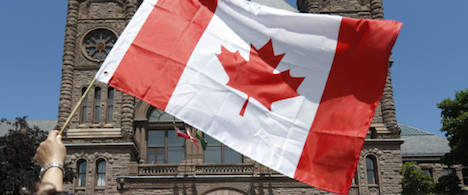Canada's complicated history with terrorism
 Print This Print This
By Nick Robins-Early, HuffPo
Huffington Post
Friday, Oct 24, 2014
 |
| Haleema Sadia, of Burlington, holds up a Canadian flag during an anti-terrorism demonstration by progressive Muslims at Queen's Park. (Bernard Weil/Toronto Star via Getty Images) | Bernard Weil via Getty Images |
The lethal attacks in Quebec and Ottawa this week have resulted in a sense of grief and alarm across Canada. Many in the nation have expressed shock at the loss of life and the breach of security -- after all, the Ottawa shooter was able to get close enough to members of parliament for them smell the gunpowder of Wednesday's shootout.
While the horrific events have taken the nation by surprise, terrorism does not have a blank history Canada. Contrary to the emerging narrative in U.S. media of a nation's "loss of innocence," Canada has a long and complicated history of violent terror attacks.
In a speech in the wake of Wednesday's attack, Canada's Liberal Party leader Justin Trudeau strongly argued against that "loss of innocence" narrative, saying that the country "is not innocent to the threats we face, and we know that we are not immune."
Terror In Quebec
Trudeau's experience with terrorism hits closer to home than for most in Canada, as his father, former Prime Minister Pierre Trudeau, presided over arguably the most heightened period of terror in the country's history.
In October 1970, a Quebecois nationalist group known as the Front de Liberation du Quebec, or FLQ, kidnapped British trade commissioner James Cross. Five days later it also took Quebec minister and senior cabinet minister Pierre LaPorte hostage. The FLQ had been known for almost a decade before, carrying out hundreds of bombings, but the kidnappings propelled the group to heightened visibility.
The government responded with a massive crackdown on Quebecois nationalists. Troops flooded the streets and civil liberties were suspended. Trudeau invoked Canada's War Measures Act, allowing citizens to be held for up to 21 days without charges. The situation escalated rapidly and public concerns over government abuse of power led to a now-famous exchange between the prime minister and journalist Tim Ralfe.
Twelve days after the first kidnapping, Pierre LaPorte was found strangled in the trunk of an FLQ car. The kidnappers of James Cross, who were from a different cell than LaPorte's kidnappers, traded their hostage for safe passage to Cuba. To date, the attacks mark the only successful kidnapping of a politician in North America.
After The FLQ
The FLQ, more of a loose collection of cells than an organized group, broke up the year after, though terrorism in Quebec would continue. In May 1984, a disgruntled army veteran broke into the Quebec National Assembly and began shooting, killing three ministers and injuring several others from his position in the speaker's chair. The attack came to a surreal end as the sergeant-at-arms -- calmly smoking a cigarette -- talked the man into peacefully giving up.
Quebec, the part of the country where linguistic and cultural tensions are most pronounced, has seen several other violent episodes. Attacks include a 2003 firebombing of three coffee shops with an English name, and a 1984 bombing that killed three and injured scores set to the arrival of the pope.
Air India Bombing
In 1985, a bomb exploded on Air India Flight 182 killing all 329 people on board as the plane flew over the coast of Ireland.
According to Terror in the Peaceable Kingdom, a report on Canada's history with terror, the bombings were "conceived and implemented" in Canada by suspected Sikh extremists who aimed the attack at Indian targets. The attack continues to be a source of controversy. Only one suspect was ever charged, and Canada's government has been widely accused of intelligence failure.
The bombing, along with a mistimed smaller explosion on another flight that killed two baggage handlers, was Canada's largest mass murder and one of the worst cases of aerial terrorism before 9/11.
After 9/11
A number of Canadian terror plots have been exposed since the tragic events of Sept. 11. The largest of these crackdowns happened in 2006, culminating in the arrests of 18 suspects who came to be known as the Toronto 18. Allegedly inspired by al-Qaeda, their reported goal was to set off three one-ton fertilizer bombs in downtown Toronto, in hopes of pressuring Canada to pull its troops out of Afghanistan.
Other al-Qaeda-inspired plots have included a 2013 plan to bomb a passenger train en route to New York, which was foiled after a tip from the local Muslim community in Toronto.
Canada After The Ottawa Attack
While more information about the motives, background and timeline of this week's attacks continues to be unpacked by Canadian media and authorities, there are serious questions about the potential fallout for Canadian politics and the nation as a whole. Already, there is a fomenting debate over the potential increase of national security measures, after Prime Minister Stephen Harper vowed to boost national security measures in the areas of "surveillance, detention and arrest."
Canada now faces big questions about how to handle terror threats, including potential tradeoffs of liberty for security. But they're questions the country has addressed before, with rationalism, calm and dignity.
Source URL
|
 Print This Print This

|

